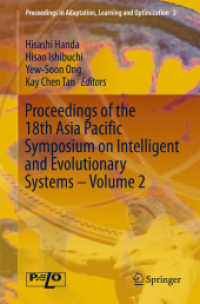- ホーム
- > 洋書
- > 英文書
- > Science / Mathematics
Full Description
A significant number of works have set forth, over the past decades, the emphasis laid by seventeenth-century mathematicians and philosophers on motion and kinematic notions in geometry. These works demonstrated the crucial role attributed in this context to genetic definitions, which state the mode of generation of geometrical objects instead of their essential properties. While the growing importance of genetic definitions in sixteenth-century commentaries on Euclid's Elements has been underlined, the place, uses and status of motion in this geometrical tradition has however never been thoroughly and comprehensively studied. This book therefore undertakes to fill a gap in the history of early modern geometry and philosophy of mathematics by investigating the different treatments of motion and genetic definitions by seven major sixteenth-century commentators on Euclid's Elements, from Oronce Fine (1494-1555) to Christoph Clavius (1538-1612), including Jacques Peletier (1517-1582), John Dee (1527-1608/1609) and Henry Billingsley (d. 1606), among others. By investigating the ontological and epistemological conceptions underlying the introduction and uses of kinematic notions in their interpretation of Euclidean geometry, this study displays the richness of the conceptual framework, philosophical and mathematical, inherent to the sixteenth-century Euclidean tradition and shows how it contributed to a more generalised acceptance and promotion of kinematic approaches to geometry in the early modern period.
Contents
1. Introduction.- 2. Oronce Fine.- 3. Jacques Peletier.- 4. François de Foix-Candale.- 5. Henry Billingsley.- 6. John Dee.- 7. Federico Commandino.- 8. Christoph Clavius.- 9. Synthesis: Continuities and Transformations in the Status of Geometrical Motion and Genetic Definitions from Fine to Clavius.- 10. Later Developments in the Seventeenth Century: a Cartesian Epilogue.






